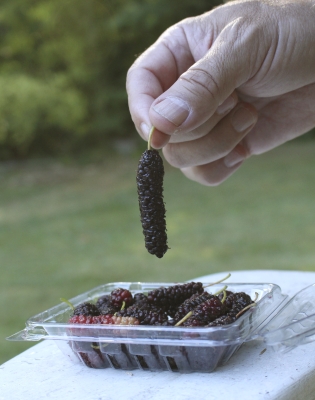PERMACULTURE(?) HERE ON THE FARMDEN
/15 Comments/in Design, Flowers, Fruit, Planning, Soil/by Lee ReichTrue Accusation?
Accusations of my being a permaculturalist, that is, a practitioner of permaculture, are true, but only partially so. Yes, I grow peppers in a flower garden and persimmon as much for its beauty (see Landscaping with Fruit) as for its delicious fruits, also integrating other edibles right into the landscape. And, like permaculturalists, I do try to maximize use of the 3-dimensional space in my farmden with, for example, shade-loving black currants growing beneath my pawpaw trees.
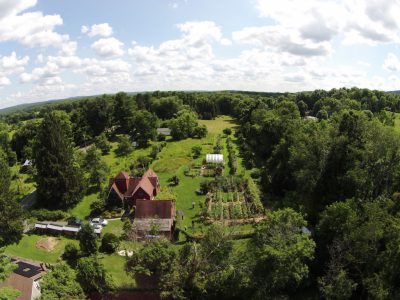
I am also a permaculturalistic in maintaining the integrity of my soil by not tilling it or otherwise disrupting the structure that builds up naturally in undisturbed soils. New ground is prepared for planting by merely smothering existing mowed or stomped down vegetation. I mulch with compost, leaves, wood chips and other organic materials to keep bare ground from ever showing.
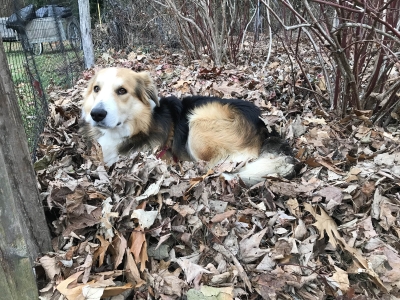
And like permaculturalists, I try to grow plants adapted to the setting so as to minimize pest problems. And poultry — ducks here on the farmden — wander freely, except in the vegetable gardens, to minimize pest problems, to provide fresh eggs, to add to the bucolic atmosphere, and to provide entertainment. And, in the shade of a Norway spruce, a rack holds up oak logs from which pop out shiitake mushrooms. I could go on.
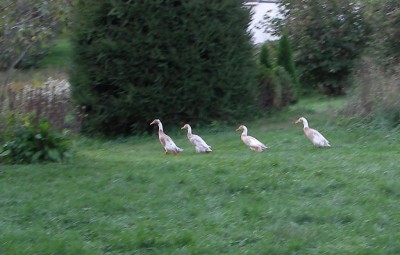
Why I Am Not a Full-Fledged Permy
Despite the assertion of one young, self-described “expert” permaculturalist, I am not a permaculturalist. I tend a permaculturesque farmden. Why the “-esque”? Because I part with true permaculturalists in a few critical ways.
Let’s begin with soil preparation. I smother existing vegetation beneath a few, typically four, sheets of newspaper topped with compost or some other weed-free, organic mulch. (I describe my methods in more detail in my book Weedless Gardening.) Many, perhaps most or all, permaculturalists prefer using corrugated cardboard from boxes as that first layer. The longevity of that cardboard on the ground is seen as an asset over paper. But I use paper so that soon after existing vegetation is smothered, the mulch and the soil below can begin to meld together. I don’t want any barrier to water and nutrients, or bacteria, fungi, earthworms, and myriad other soil organisms in place any longer than necessary.
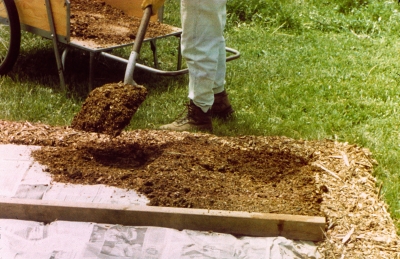
I part ways with permaculturalists by growing my vegetables rectilinearly, in straight rows within rectangular 3-foot-wide beds. Yes, the idea of organically shaped beds and keyhole gardens is very appealing –- on paper. But time, my time, is also an important element in the garden, and it takes a lot longer to maintain curved and somewhat randomly shaped bed than it does rectilinear beds.
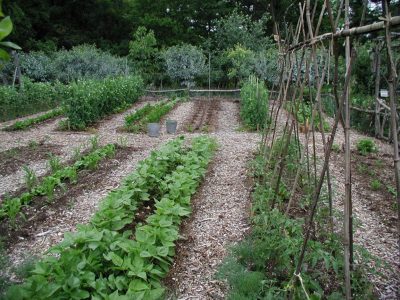
And then there’s the permy way of tucking, say lettuce plants, beneath fruiting shrubs and trees. But I eat a lot of vegetables and there’s nothing like straight rows running down straight beds for packing a lot of vegetables into a given area, and making planting, weeding, and harvesting quicker and easier. When I go out to pick some vegetables for a meal, I don’t want to be remembering where I tucked the lettuce and wending my way through trees and then crawling beneath some shrub to get at it.
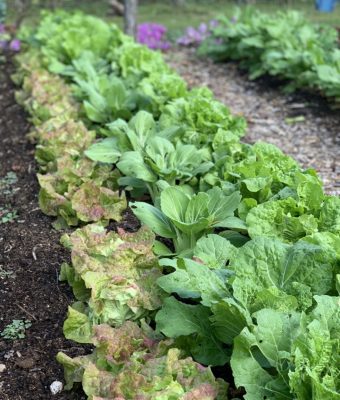
Permaculture originated and thrives in the dry climates of Australia and our Southwest. Over much of the country, and especially here in the Northeast, rainfall coaxes very exuberant growth from crop plants and weeds alike. Too many permaculturalists are liable to spend their first few permaculture years admiring their efficient and attractive use of space, and all the years hence cursing all the time needed cutting and weeding needed to keep growth of various plants in balance. What I need are some straight lines and a little elbow room.
(I have been hired more than once as a consultant on a property designed and planted by a true permaculturalist. I’m sure it looked great on paper and for the first few years, until it became a tangled mass of plants, more than most people could handle long term. Sometimes, the best course moving forward is to remove everything for a fresh, perhaps permaculturalesque start this time around. As one landowner told me, “a few years back I was ‘permacultured’ by some fine folks. I have been fighting my way back ever since.”)
“Forest gardening,” growing and eating from your planted forest, is receiving growing interest within permaculture circles. As you might guess, I’m also not a forest gardener, despite the fact that I have integrated fruiting trees, which do come from forests somewhere, as well as chestnuts, English walnuts, black walnuts, and other nutty things into my landscape.

Planted “forest”
I do have a miniforest in a portion of my meadow. The cool shade beneath the now large buartnut, shellbark hickory, maple, and river birch trees is not planted with herbs and vegetables for nibbling. It’s mostly a leafy mulch that fall in autumn, as in any forest floor. Oh, with a bow to forest gardening, I also planted ramps there.
I plant fruits, vegetables, and nuts to provide sustenance, not just a nibble here and there.
I Aim for Good Food, Not a Concept
I’m growing my own fruits and vegetables because I want great-tasting food. It seems to me that permaculture is usually about making growing plants easier. Nothing wrong with that, of course, except sometimes plants that are easiest to grow aren’t those that have the best flavor. I grow elderberries (back in my more hard-core permaculture planting along with aronia, rosa rugosa, seaberry, and highbush cranberry). Could anybody claim that a fresh picked elderberry can hold a candle to, flavorwise, a fresh picked blueberry?
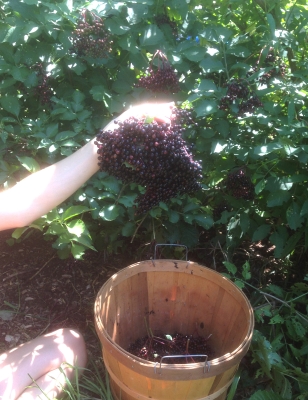
Elderberry harvest
Speaking of blueberry, they are easy to grow. But, if you want best production of flavorful berries, best to put some effort into getting the soil right, pruning correctly and annually, and netting to fend off birds so you can harvest truly ripe berries. Grapes? They need abundant sunlight, not the shady but easily supplied support of a nearby tree, for best quality and easy picking. Pruning is critical for topnotch flavor and pest control. It all takes effort, but is worth it.
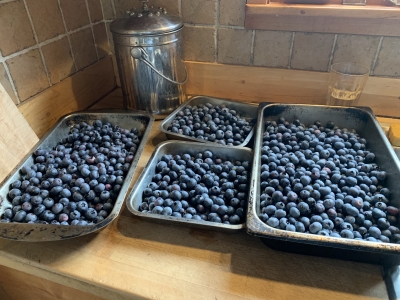
Today’s blueberry harvest
Although I am very intimate and knowledgeable about the plants I grow, I am no expert on permaculture. Perhaps I have misconstrued certain permaculture techniques or am totally missing the concept (even though I was accused of being a permaculturalist). I welcome feedback.
FRUITS IN THE KITCHEN AND FRUITS ON THE TREE
/12 Comments/in Fruit/by Lee ReichCall for Recipes
About 30 years ago I wrote a book about fruits that were uncommon yet were uncommonly delicious and uncommonly easy to grow. That book has since gone out of print. It will soon be back in print, updated with additional “uncommon” fruits and, this time around, recipes.
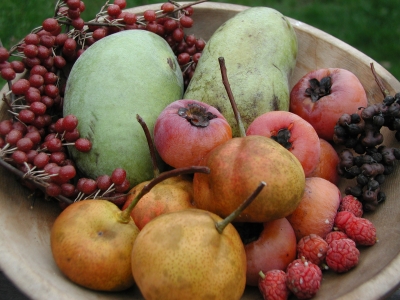
The fruits I wrote about are all excellent eaten fresh. I am quite good at growing fruits; not so for doing anything else with them beyond transporting them from hand to mouth.
I am eliciting recipes from chefs and amateurs who have access to any of these fruits and can conjure up delicious jams, soups, tarts, salads, desserts, etc. — savory or sweet — that truly highlights their unique flavors. (I’ve read too many recipes that take a smidgen of fruit and stir it up with plenty of flour, sugar, butter, cream, whatever; to me that’s not really highlighting a fruit’s unique flavor or texture.)
I will, of course, credit any recipes published with their inventor as well as affiliations. Here’s a list of the fruits. It’s a list chapter headings and subheadings from the book. I have grown all of them and can vouch for their fresh flavors. So please send me your recipes, as “reply” to this blog or, preferably, as email.

OLYMPUS DIGITAL CAMERA
•Juneberry: A Cosmopolitan Blue Berry (Amelanchier spp.)
•Beach Plum: A Tasty Fruit Not Just for the Beach (Prunus maritima)
•Alpine and Musk Strawberries: Diminutive Delectables (Fragaria vesca, F. moschata)
•Raisin Tree: Candied Fruit for the Picking (Hovenia dulcis)

•Lingonberry: Dainty Looks, Sturdy Disposition, and Tasty Berries (Vaccinium vitis-ideae)
•Actinidia: Emeralds in the Rough (Actinidia arguta, A. kolomikta)
•Mulberry: A Summer Fruit-of-Many-Colors (Morus spp.)
•Kaki and American Persimmons: Fruits of the Gods (Diospyros kaki, D. virginiana)
•Elaeagnus: Gumi, Autumn Olive, and Russian Olive (Elaeagnus spp.)
•Gooseberry: Fruit with a Checkered Past (Ribes uva-crispa, R. hirtuellum)
•Maypop: A Passionflower for the North (Passiflora incarnata)
•Che: Chewy Dollops of Maroon Sweetness (Cudrania tricuspidata)
•Black Currant: Fruit from Fragrant Bushes (Ribes nigrum, R. odoratum)
•Nanking Cherry: Cherries on a Bush (Prunus tomentosa)

•Cornelian Cherry: From the Shores of Ancient Greece (Cornus mas)
•Currants, Red and White: Sprightly, Translucent Jewels (Ribes petraeum, R. rubrum, R. sativum)
•Asian Pear: The Crunch Pear (Pyrus pyrifolia, P. ussuriensis, P. × bretschneideri
•Jostaberry: The Gooseberry and Black Currant Hybrid (Ribes nidigrolaria)
•Lowbush Blueberry: More American Than Apple Pie (Vaccinium angustifolium)
•Jujube: The Chinese Date (Ziziphus jujuba)

•Shipova: A Sweetie with a Blush (×Sorbopyrus auricularis)
•Medlar: Lost in the Middle Ages (Mespilus germanica)
•Seaberry: Northern flavor of oranges and pineapple (Hippophae rhamnoides)
•Black raspberry: Wild, but Worthy of Cultivation (Rubus occidentalis)
Hedging my Bets
This year has been such a bountiful year for fruits that even my peach tree has set fruit. Peaches are particularly pretty trees, in bloom showered with pink blossoms and the rest of the season with their healthy-looking, lance shaped leaves that gracefully curve downwards. Since I rarely get fruit from my tree — late frost, plum curculio, brown rot, and oriental fruit moth, among other maladies — I actually grow it mainly as an ornamental.
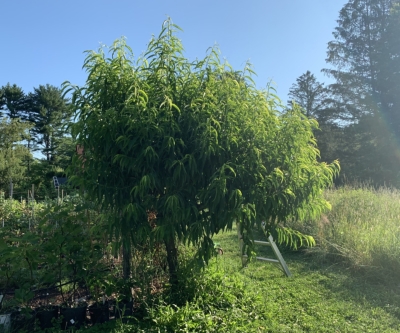 Because I grow it mostly as an ornamental and because it grows right near one corner of my vegetable garden, I don’t want it to grow too large. Last year at about this time I decided to hedge its crown into a pleasing shape.
Because I grow it mostly as an ornamental and because it grows right near one corner of my vegetable garden, I don’t want it to grow too large. Last year at about this time I decided to hedge its crown into a pleasing shape.
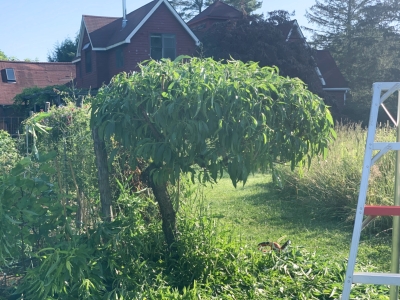
Peaches bear fruit on one year old wood. I figured the unpruned lower portions of the hedged branches would set fruit buds in case the tree, in conjunction with the weather and pests, was inclined to set fruit the following year. That’s this year, and the tree is bearing fruit.
I do prune again in spring while the tree is still dormant. Plenty of thinning cuts are needed to decongest the branches. Also some heading cuts to stimulated buds to grow into shoots for the following year’s flowers and fruits.

Yesterday I again hedged the tree down to shapely proportions, allowing it the possibility of a fruitful repeat performance next year.
UNCOMMON BERRIES, FOR SOME
/16 Comments/in Fruit/by Lee ReichNote: If you live in a very hot summer climate, skip Part A and proceed to Part B.
Part A. Perfect for Ambulant Consumption
Part A. It’s about time that gooseberries got some respect. The plants are easy to grow, they tolerate shade, are usually ignored by deer and birds, except my ducks, and they can have excellent flavor. They don’t do very well or yield the tastiest fruits in hot summer climates, hence “Skip to Part B,” although the coolness of shade can somewhat overcome that deficiency.
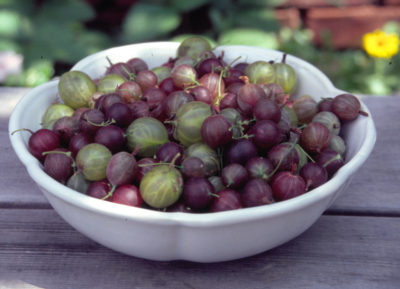
Gooseberry flavor is what eludes most people. And with good reason; relatively few of you have tasted gooseberries, let alone good-tasting varieties. The reason is that gooseberries belong to the Ribes genus, many plants of which are susceptible to a disease called white pine blister rust. This disease, also attacking white pines, need both white pines and susceptible Ribes plants to complete its life cycle.
When the rust showed up on American shores about 100 years ago, white pine was an important lumber crop so the U.S. government sought to control the rust be getting rid of all Ribes plants. Not only were gooseberries illegal to plant but if you already had gooseberries or currants, another Ribes species, in your garden, fellas from the Civilian Conservation Corps were apt to descent out of the woods into you garden to rip them out.
Long story short: Before the rust, gooseberries were an up and coming fruit, just like blueberries, which were relatively unknown except near where they grew wild. The ban was not as effective as was hoped. Disease could spread from the many wild Ribes haunt that our woodlands, and under the right conditions infective spores can be carried for hundreds of miles. On top of that, gooseberries and redcurrants are not very susceptible to the fungus.
The federal ban was lifted in 1966 and put under state mandate, but two generations of farmers and gardeners had forgotten about gooseberries. Relatively few states nowadays ban gooseberries.
Dessert (vs Culinary) Gooseberries
I once nurtured my own gooseberry variety collection of almost 50 varieties, a collection that now has been pared down to the most desirable dozen or so. I only grow what are known as “dessert” varieties of gooseberry, ones that have great flavor straight off the bushes. As Edward Bunyard wrote in his 1929 classic The Anatomy of Dessert, “The gooseberry is the fruit of course par excellence for ambulant consumption.”

This growing season has, so far, been one of the best fruit years ever, so I’m taking particular note of ripening time and flavor of my gooseberries. (Like a fine wine, though, they do seem to have vintage years.) First to ripen here is the variety Canada 0-273; its main qualities are that the plant is always productive and yielding large and early fruit.
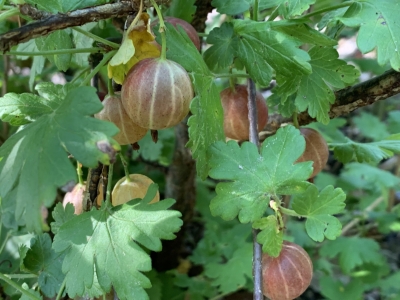
Canada 0-273 gooseberry
Next comes Poorman, an unfortunate name for a very delectable berry. Almost ripe now is Captivator, the variety I would grow if I were to grow only one variety. It’s delicious and pretty much thornless.
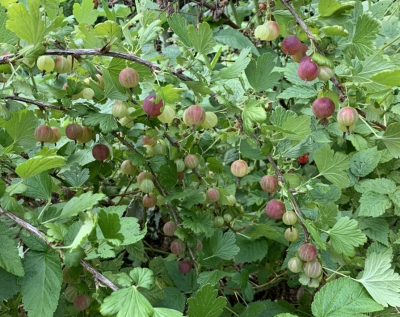
Poorman gooseberry
Soon to ripen are Red Jacket, very reliable and productive, with good flavor, and Welcome. Welcome is still with me for sentimental reasons; it was one of the first fruits I ever planted, decades ago, and has traveled with me to my gardens from Wisconsin to Delaware to Maryland to New York. It’s flavor is very similar to “SweeTart” candies.
Following the above varieties is another variety that would be on a must have list. Hinnonmakis Yellow is yellowish-green when ripe and has a flavor that hints of apricot. Some people confuse it with Hinnonmakis Red, which has poor flavor, and whose real name is, I believe, Lepaa Red. Also soon to ripen is Black Satin which has a rich, wine-y flavor.
That’s not all of them but does give you an inkling of the merits of the most significant ones. There are literally hundreds of varieties of gooseberries, spurred in part beginning in 18th century England, by gooseberry competitions, held usually in local inns, to see who could grow the largest fruits. The gaiety of singing and refreshments at these shows was offset by the solemn weighing of fruits.
Those gooseberries were bred strictly for size. I plant for flavor. Did I mention, pest problems of gooseberry? Powdery mildew and leaf spot diseases are potential problems but all the varieties I mentions are resistant to these diseases.
For more about the growing, the varieties, etc. of gooseberries, see my book Grow Fruit Naturally.
Part B. Some Mulberries are Better than Others
Part B. Some kind of mulberry can be grown just about everywhere. Here in the Hudson Valley, we have wild or cultivated red mulberries, which are native, white mulberries, most of which were imported from Asia in the early 1800s, and hybrids of the two. Don’t expect the color of a tree’s fruit, despite even the botanical names, Morus rubra and M. alba, to tell you what species you have before you. Many “white” (M. alba) mulberries or their hybrids bear black fruit.
To throw yet another wrench into the nomenclature, there’s yet another species, M. nigra or black mulberry, with black fruits. I consider black mulberry to be among the best-flavored of all fruits, not just mulberries. Unfortunately, it’s not hardy here. I grow it in a pot.

Black mulberry, M. nigra
Most years birds get just about all my mulberries; not this year, perhaps because of an abundance of other fruits. So I’ve been getting a good taste of them.
I find the flavor of most wild mulberries cloying. Not so for the two varieties I grow.
I, along with many others, have lent high praise to the variety Illinois Everbearing, often likening its flavor to that of black mulberries. This year I’ve reconsidered; Illinois Everbearing fruits are better than the average mulberry you might see growing in Eastern North America, but not nearly as good as black mulberry. Illinois Everbearing does live up to the “everbearing” in its name, yielding berry after berry for weeks on end.
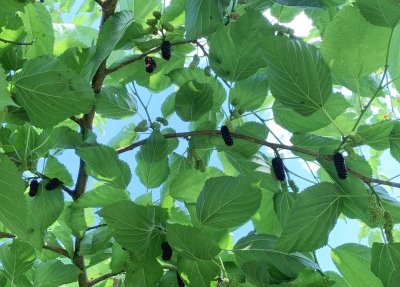
Illinois Everbearing mulberry
My other variety is Oscar. It’s delicious, with a nice balance of acidity and sweetness.
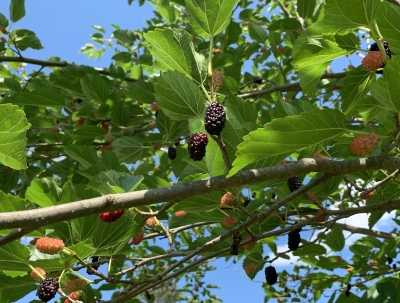
Oscar mulberry
Other years my impression of the two varieties has been different. Perhaps mulberries and gooseberries have vintage years that influence the flavors of particular varieties.
I actually grow one more variety of mulberry, Pakistani. This is yet another species, M. Macloura, that was once considered a kind of white mulberry. Pakistani, like black mulberry isn’t hardy here (probably hardy to Zone 7, perhaps colder) so I grow it in a pot. The fruit is delicious and large, sometimes as much as five inches long! My potted tree’s fruits are only an inch and a half long, but they’re as delicious as black mulberries. Different flavor though.
